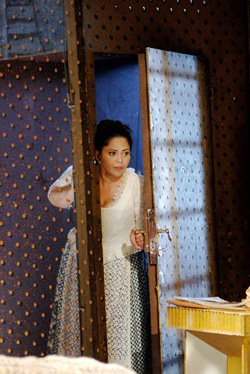
As part of the Forms of Love core course, on February 26th students and professors attended a showing of Le Nozze di Figaro at the Staatsoper Berlin at Schiller Theatre.
In conjunction with this, Professor Geoff Lehman organized a preparatory discussion on the piece’s creative use of music to illuminate the narrative. The Marriage of Figaro, subtitled ossia la folle giornata or The Day of Madness, was composed in 1786.
It was the first union of Mozart’s music with Lorenzo Da Ponta’s libretto, a collaboration that would occur again with Don Giovani and Cosi fan tutte. ECLA’s attendance to this production complemented the students’ visit to Il Barbiere di Siviglia by Rossini at the beginning of the fall term, also at the Staatsoper Berlin. That Rossini opera was based on the original Figaro play of French satirist Pierre Beaumarchais.
The second play in Beaumarchais’ Figaro series (Le Mariage de Figaro) is the basis for Mozart and Da Ponta’s work. Oddly enough, Rossini’s opera was composed thirty years after The Marriage of Figaro.
Daniel Barenboim’s conducting accompanied a story of mishaps and romance on the wedding day of Susanna and Figaro. Both are servants to a duplicitous Count and his patient wife. Near the start of the first act, as Figaro and Susanna arrange furniture in their new residence, the Count’s intention to seduce Susanna is revealed.
Figaro is bent on punishing the Count, but only through a game of wits that embarrasses him (“Se vuol ballare”). An aria of Bartolo (“La vendetta, oh la vendetta”), a doctor who despises Figaro, immediately follows and musically and thematically reflects Figaro’s want of embarrassment.
The production owed much to the performance of Cherubino, played by Christine Schäfer, a young boy overly eager to expand his romantic experience but whose innocence is still depicted through the melody of his aria “Non so piu cosa son”. Events lead Cherubino to be pushed away by the Count, and the end of the first act is a very merry rendition of “Non piu andrai,” where Figaro instructs Cherubino (ironically played by a woman) on how to be a proper man.
The Countess goes without being seen until the second act, where her patience is heartbreakingly communicated in “Porgi amor, qualche ristoro”. Dorothea Röschmann’s performance of this piece was the highlight of the show. The opera consistently presents relationships where trust in a beloved’s faithfulness is thrown into doubt. All events of the opera occur in a single day, and as it is shown later the comic situations become more complicated.
The stage arrangement of this production reinforced the increasingly solemn tone of the opera through darkness on the set, so much that it was difficult to see the actors, and added eeriness to the stage design. The inventive element of these switches is that it still incorporates traditional comedic practices, such as Susanna and the Countess disguising themselves as one another in Act IV. Musically, the drama most perturbing amidst the opera’s lightness is depicted in Susanna’s aria “Giunse alfin il momento.”
The finale of the fourth act offers both a tragic and joyous climax to the opera. The Count is at the height of his anger when he finds Figaro being affectionate toward Susanna dressed as the Countess. Susanna-as-the-Countess begs for his forgiveness (perdona, perdona!!) but he refuses, repeating that he will denounce her. Then the true countess comes on stage, showing that it is the Count that needs to be forgiven.
The melody quickly switches from lively and rushed to a melancholic tempo that reminds one of a hymn (“Cotessa, perdona”). This is best depicted after the Countess forgives him, and all on stage gloomily sing, “Ah! Tutti consenti Saremo Cosi” as would be found in a requiem, though through words and the narrative context of reconciliation.
Immediately after, however, the vibrancy of the music rousingly returns. The opera concludes in this manner. What is to be made of the brief hymn-like solemnity during the moment of forgiveness in a comedic opera? The day of the opera’s setting may be like many others in the lives of the characters.
The numerous adventures of the plot could be merely incidental, as the final rousing call for merry music and laughter suggests. Or maybe the very nature of love, as embodied by the Countess, is more demanding, calling for a sorrowful sound that disrupts the casual rush.
Michael David Harris (AY’12, USA)
